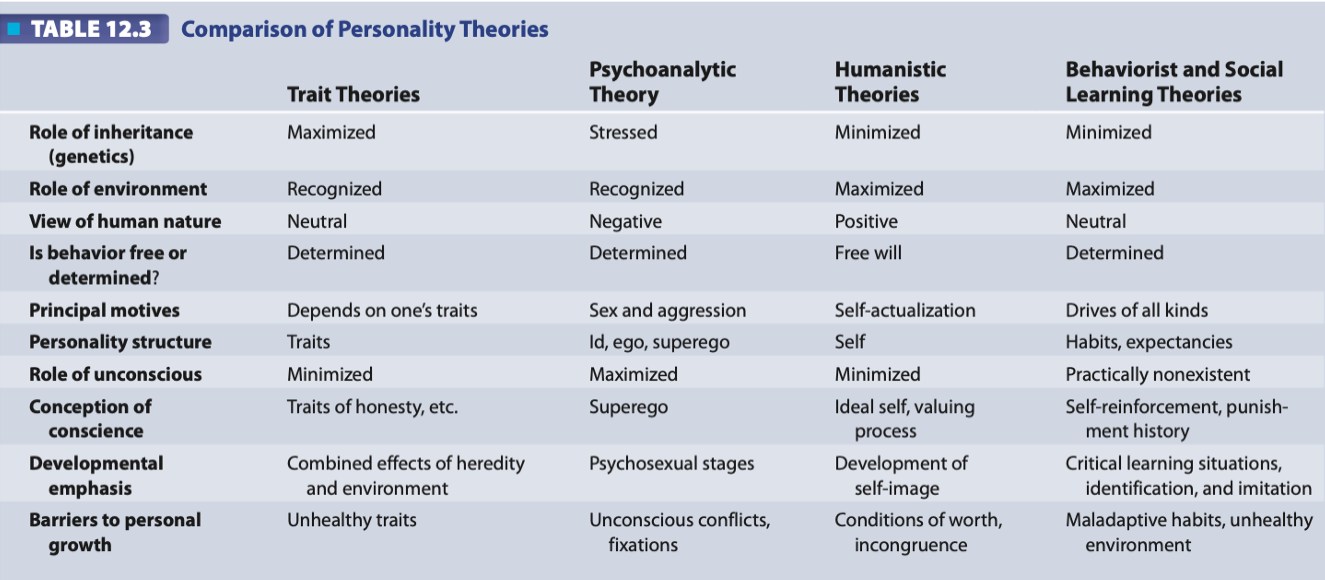Personality
Definition (#f7aeae)
Important (#edcae9)
Extra (#fffe9d)
Key Concepts:
Understanding Personality
Personality Theories:
Trait Theory
Psychodynamic Theory
Humanistic Theory
Personality Assessments
Understanding Personality:
Personality: Unique, long-term pattern of thoughts, emotions & behaviour.
Provides consistency over time; shaped by talents, values, habits.
Self-concept: Perception of own traits → guides attention & memory.
Self-esteem: Evaluation of worth (cultural split: individualistic vs collectivistic).
Traits: Relatively stable differences across situations; allow behaviour prediction.
Trait–situation interaction: Situations can modify trait expression.
Personality type: Cluster of common traits (e.g., introvert, extrovert, hardy).
Personality Theories:
Personality Theory: System of concepts, assumptions, ideas, and principles proposed to explain personality.
Four main traditions: Trait, Psychodynamic, Humanistic, Behaviourist/Social-Learning.
Trait Theory:
Goal: Identify traits & link them to behaviour & personality; traits often viewed as biologically based.
Gordon Allport identified several traits:
Common: Characteristics shared by most members of a culture.
Individual: Define a person’s unique personal qualities.
Cardinal: So basic that all of a person’s activities can be traced back to the trait.
Central traits: Core qualities of a personality.
Raymond B. Cattell studied traits & found:
Surface traits: Visible features of personality.
Some traits may tend to cluster together to represent a more basic single trait.
Source traits: Deeper characteristics, or dimensions of personality.
Cattell identified 16 source traits → 16PF Questionnaire that produces a trait profile. To fully describe personality, we need all 16 traits.
Big 5 factors: Extroversion, Agreeableness, Conscientiousness, Neuroticism, Openness.
Extraversion: Introverted or extroverted.
Agreeableness: How friendly a person is.
Conscientiousness: Self-disciplined, responsible and achieving
Neuroticism: Negative emotions, anxious, emotional (in)stability.
Openness: open to new ideas.
Psychodynamic Theory:
Behaviour driven by unconscious forces.
Psyche structures:
Id: Pleasure principle, instincts, libido (life & death drives).
Superego: Moral principle, internalised parent, pride/guilt.
Ego: Reality principle, rational mediator.
Levels of awareness: Conscious, preconscious, unconscious (Freudian slips).
Psychosexual stages: (Fixations influence adult traits):
Oral (0-1 Years)
Anal (1-3 Years)
Phallic (3-6 Years) – Oedipus/Elektra complexes
Latency (6- puberty)
Genital (puberty +)
Neo-Freudians:
Adler: striving for superiority, compensation, inferiority complex
Horney: basic anxiety, challenged "penis envy" & male bias
Jung: personal vs collective unconscious, archetypes
Humanistic Theory
Emphasises free will, personal growth, subjective experience.
Maslow:
Self-Actualisation: Process of fully developing personal potentials, or a continuous search for personal fulfillment.
Characteristics: Acceptance of others, spontaneity, efficient perceptions of reality, comfort with solitude.
To promote self-actualisation: Encourage change, responsibility, honesty, involvement.
Rogers:
Fully functioning person: Lives in harmony with their impulses, open to experiences.
Fully functioning person; self-image vs ideal-self → incongruence blocks growth.
Self: Flexible and changing perception of personal identity.
Incongruence: State which exists when there is a discrepancy between one’s experiences and self-image or ideal-self.
Comparison Snapshot

Personality Assessment
Interviews: Face-to-face meeting designed to gain information.
Structured: Follows a prearranged plan using a series of planned questions.
Unstructured: Conversation is informal, topics are discussed as they arise.
Subject to bias & deception.
Direct Observation: Assessing behavior through direct surveillance.
Rating Scale: List of personality traits or aspects of behavior used to evaluate a person.
Behavioral Assessment: Recording the frequency of specific behaviors.
Situational Test: Realistic situations are simulated so that someone’s spontaneous reactions can be observed and recorded.
Questionnaires: Paper and pencil measures consisting of questions in which the examinee will rate.
MMPI-2: Minnesota Multiphasic Personality Inventory-2. Widely used with 567 test items and many sub-scales.
Big-5 Personality Tests.
MBTI: Myer-Briggs Type Inventory.
DISC: Dominance, Influence, Steadiness, Conscientiousness.
Projective Tests: Tests that use unstructured stimuli; person needs to describe the stimuli or make up stories about them.
Seeks to uncover deeply hidden wishes, thoughts and needs.
Rorschach Technique: 10 standardized inkblots.
Thematic Apperception Test (TAT): 20 drawings of various situations; people must make up stories about the drawings.